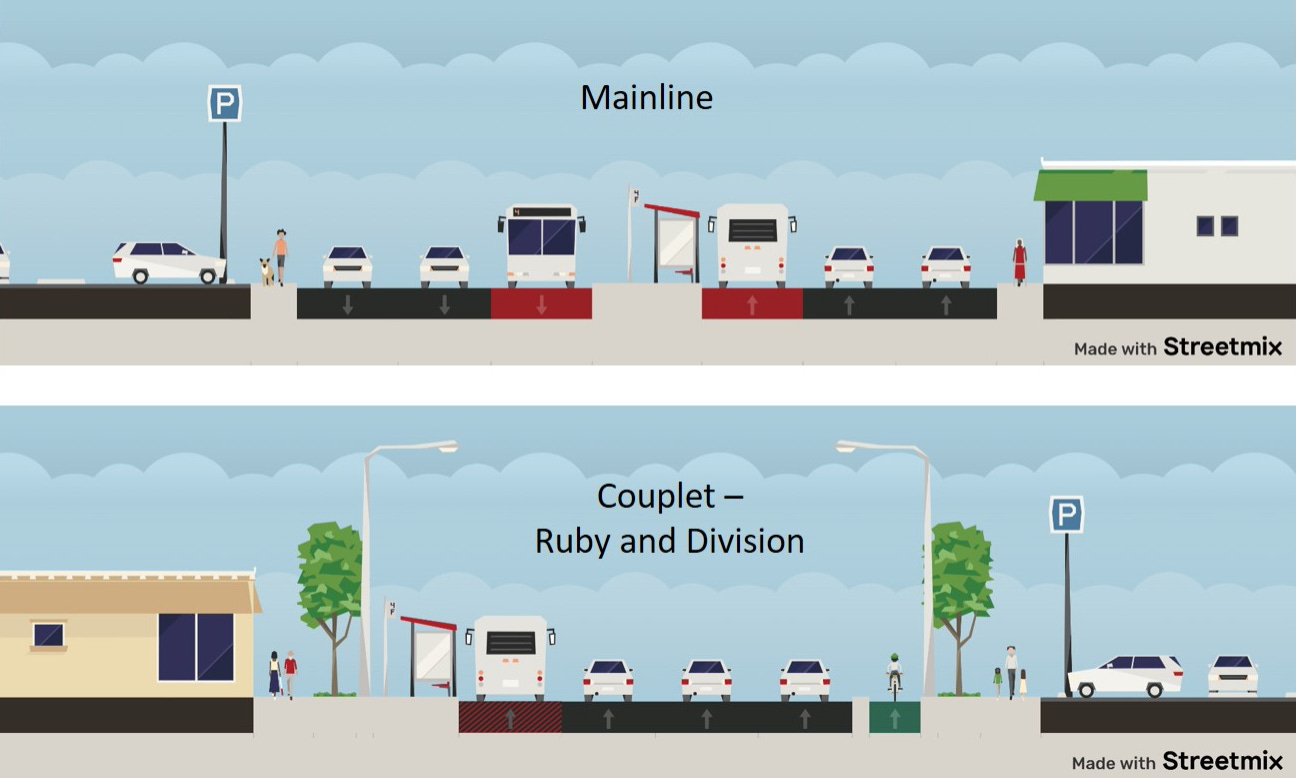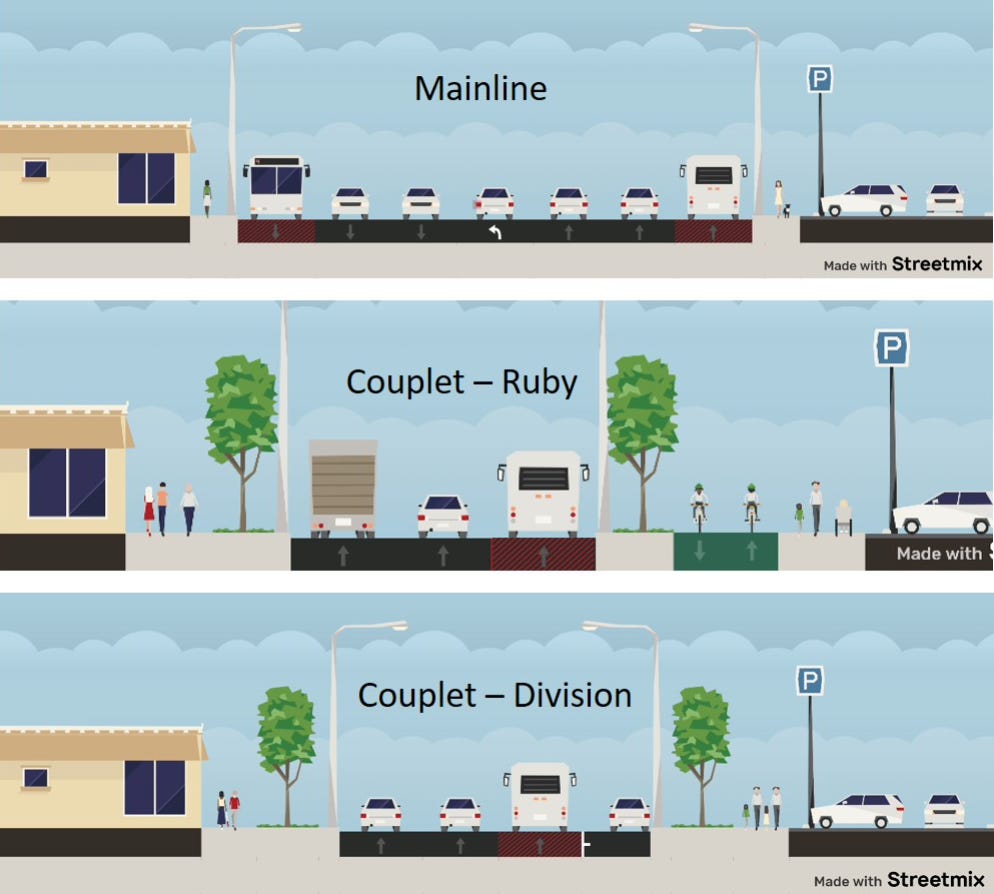BRT considered along North Division

The Spokane Regional Transportation Council has partnered with WSDOT, the City of Spokane, Spokane County, and Spokane Transit Authority on a major transportation and land use study along the North Division corridor. The Division Connects project is analyzing the future of transit along the corridor, with the US-395 North Spokane Corridor set for completion in nine years.
The project's key objectives include:
Identifying a preferred concept for bus rapid transit (BRT) along North Division.
Developing options for all modes within the corridor, including pedestrian and bicycling improvements.
Identifying opportunities for land use improvements.
Recommending capital project implementation plans to fund improvements.
The first phase of work involved production of a "State of the Corridor" report, which was completed in late spring 2020 and reviewed the existing travel patterns and land use patterns along North Division. It mapped the existing streetscapes along the corridor, travel times, transit ridership, and transit reliability.
The second phase, underway now, is analyzing four scenarios for possible streetscape improvements to accommodate BRT, bicyclists, and pedestrians. Let's dive deep into the weeds.
Alternatives

The current alternatives divide the corridor into two distinct sections.
"Mainline" describes the northern portion of the corridor between the Ruby/Division couplet and the North Division "Y," while "Couplet" describes the southern portion of the corridor, which is divided between Division southbound and Ruby northbound.
Alternative Center-running

In the "mainline" portion of the corridor, the center-running alternative is the most ambitious, with center-running BRT with dedicated transit lanes and two general-purpose lanes in each direction.. Stations would be located in the center of the Division right-of-way,, with some left turns accommodated for vehicles and others prohibited.
Ominously, the plan states that "active transportation facilities would be provided in a parallel corridor." This creates challenges for pedestrians and bicyclists in getting to the parallel corridor, could decrease the appeal of the BRT line, and might not result in as many positive land use changes along this section.
In the "couplet" portion of the corridor, the center-running alternative is less ambitious, with the left lane dedicated to a Business Access Transit (BAT) lane, three general purpose lanes, and a single protected bike lane on the right side. Wider sidewalks and planting buffers would improve the pedestrian experience. This layout would be mirrored on both Ruby and Division.
Possible Improvements:
Better accommodation for pedestrians and bicyclists in the "mainline," to ensure safe access to the center-running BRT stations.
Make the BAT lanes bus-only with proper enforcement.
More ambition in the "couplet," including two-way protected bike lanes or street-front parking to improve the pedestrian environment and encourage land use changes. This could require removing a general purpose lane in each direction.
Alternative Side-running A

In the "mainline," this alternative is less ambitious, with BAT lanes in each direction, two general-purpose lanes in each direction, and a two-way center turn lane. Again, pedestrians and bicyclists would be pushed to parallel corridors. This would create serious problems in terms of crossing the street to get to the other direction of the BRT line.
In the "couplet," this alternative looks similar to the center-running alternative, but with the bus lane and the protected bike lane flipped. Wider sidewalks and planing buffers would improve the pedestrian experience.
Possible Improvements:
Significantly better accommodations for pedestrians in the "mainline," particularly near BRT stations, to ensure people can easily reach the opposite side of the street.
More ambition to the "couplet," including two-way protected bike lanes or street-front parking tot improve the pedestrian environment and encourage land use changes. This could require removing a general purpose lane in each direction.
Alternative Side-running B

In the "mainline," this alternative is identical to Alternative Side-running A.
In the "couplet," this alternative makes significant changes, converting both Ruby and Division to two-way operations. Ruby would be designated as a multiuser corridor, with two-way bus-only lanes, protected bike lanes, and one general purpose lane in each direction. Division would have two general purpose lanes in each direction, one center turn lane, and on-street parking. This alternative is perhaps the most ambitious along the "couplet."
Possible Improvements:
Significantly better accommodations for pedestrians in the "mainline," particularly near BRT stations, to ensure people can easily reach the opposite side of the street.
Make the BAT lanes bus-only with proper enforcement.
More ambition to the Division portion of the "couplet," particularly at the southern end where the corridor meets Ruby and crosses into Downtown Spokane.
Alternative Side-running C

In the "mainline," this alternative is identical to Alternative Side-running A.
In the "couplet," this alternative features two general purpose lanes and one BAT lane in each direction. A two-way cycle track would be provided on Ruby and one lane of on-street parking would be provided on Division. Overall, this provides a good alternative in that it balances uses and costs, but it doesn't have the ambition of Side-running B.
Possible Improvements:
Significantly better accommodations for pedestrians in the "mainline," particularly near BRT stations, to ensure people can easily reach the opposite side of the street.
Make the BAT lanes bus-only with proper enforcement.
Ensure curb bulb-outs and other pedestrian enhancements in the "couplet," to ensure pedestrian safety even when there are three lanes of traffic.
Next Steps
Overall, this project has significant appeal as it could dramatically improve the experience for transit users, bicyclists, and pedestrians along Division. Some of the alternatives could use significantly more ambition in order to make the greatest amount of difference and induce positive land use changes.
Staff are expected to make a recommendation on a preferred alternative in late February. The public can share comment here. We strongly encourage comments urging better, more ambitious alternatives for bicyclists, pedestrians, and transit users.




